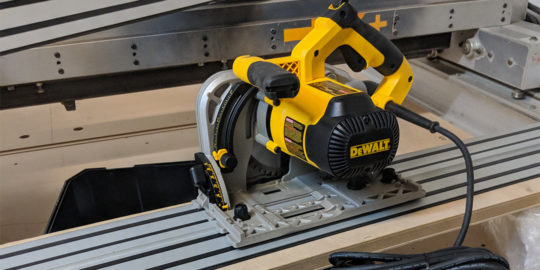 Loading asset information.
Loading asset information.
Make/Model: Dewalt DWS520
Documentation:Manual PDF
Learn From A Video: https://www.youtube.com/watch?v=3By4OD4zIkA
About the track saw
The track saw is used to make straight cuts in sheet goods or large pieces that would be difficult to manage on the table saw or the panel saw. It is not for crosscuts – use a miter saw or the tables aw. A track saw can be used to cut wood, wood composites, hardboard, or cardboard and some other paper-based goods. The track that the tool rests on ensures that it travels in a straight line. This means that the tool can also be useful for establishing a reference edge to use with the rip fence on the table saw. If both sides are irregular, but you need to create two parallel edges, you can make your first cut on the track saw and then move to the table saw…making best use of the mechanical advantages each provides. The track saw can also cut bevels, just like the table saw.
Inspect Before Use
- Check the power cable for breaks, fraying or obvious wear
- Check dust port and vents for dust clogs and clear them out if necessary
- Check that the blade housing is clear of any debris
- Push the plunge trigger forward and press the blade down to test the plunge function
- Check that the riving knife is properly adjusted (it should be 2-3 mm deeper than the bottom of the blade)
- This should be done as part of regular maintenance, so you shouldn’t need to do it. If it needs adjustment, check the manual on the wiki if you’re comfortable doing it. If not, post to slack that it needs to be adjusted.
- Inspect the track for damage that may prevent travel or allow the saw to drift
- Including for damage to the edges, or the rubber anti-splinter strip that is on the edges
- Inspect the track channels on the shoe to ensure they are clear
- Place the saw on the track and test its travel
- Disengage the anti-kickback knob if you need to pull the saw back towards you, but do not do this while the saw is running
- Adjust the cutting depth of the blade.
- You want about half a tooth extending beyond your workpiece.
- Ensure that your workpiece is properly raised and supported
- If cutting a bevel, test bevel adjustment and locks, before setting your angle
- Plug the tool in and test run the blade (without plunging)
Safe Use
- Don’t put your hand near the underside of the tool while it’s plugged in
- Raise your workpiece on supports, and ensure that it is supported on both sides of the cut
- The outside edges of the workpiece should be supported, and it should be supported for its full length on either side of the cut
- The piece to be offcut does not NEED to be supported on the outside edges, but it’s good practice
- Supports can be strips of wood, a sheet of foam or wood.
- You can also cut over open space if you cut over the side of the workbench, but only if little is being cut off an edge.
- Find a way to clamp your workpiece and the track down so that neither can move
- Ensure that the power cable will remain clear of the cutting path
- Always keep two hands on the tool while the blade is spinning
- Never pull the tool towards you, always push from the rear
- Make sure that you’ll be able to control the tool without excessive reaching
- Adjust the fit on the track if needed by loosening and adjusting the eccentric cams on the front and/or back of the base
- Make sure the anti-kickback knob clockwise is engaged before cutting (recommended but not required)
- Make sure the blade comes up to full speed before starting a plunge or cut
- When cutting, don’t move the saw faster than it wants to cut
- If you feel resistance, you’re moving too fast
- If the blade binds or stalls, release the power trigger immediately
- Do not attempt to restart a stalled cut within the kerf
- Clear the blade from the cut, move back several inches and bring the blade up to full speed before plunging again
- No vertical cutting in the shop with this tool; horizontal only
- Watch for kick back when:
- Starting or finishing a cut on the edge of the piece
- Cutting narrow strips
- If cutting narrow strips, make sure that they aren’t feeding up inside the blade housing
- Workpiece is improperly supported and is sagging
- Use extra care if cutting green, wet or pressure treated wood
Making a Cut
- Always use dust collection (this tool can be connected to the mini cyclone attached to the sanding station/router table)
- Place your workpiece with the face (show side) down
- If tear out occurs, it will be on the upper side, as the blade cuts from the bottom up
- You can also attach blue painters tape along the cut path to reduce tear out
- Ensure that the workpiece and the track will not move during your cut – both should be clamped
- If cutting a bevel, adjust the blade angle
- Line up the track for your cut
- You may be better off using a physical reference than a tape measure to line the track up…it depends on what you’re trying to do
- Make sure to use the right side of the track for the type of cut you are making (straight vs. bevel)
- Set your cutting depth
- Adjust the speed wheel
- Wood 3-5: (soft to hard)
- Chipboards: 4-5
- Laminated wood, blockboards, veneered and coated boards (i.e. MDF): 2-5
- Paper or carton: 1-3
- Test the travel of the saw
- Make sure you can control it throughout the cut without reaching
- You may need to disengage the anti-kickback knob to move the saw back to the start of your cut
- Adjust the fit on the track if needed by loosening and adjusting the eccentric cams on the front and/or back of the base
- Make sure to engage the anti-kickback knob before starting your cut (recommended but not required)
- Plug the tool in
- Push the plunge trigger (which acts as a safety switch) forward and squeeze the power trigger and bring up to full speed
- Push the saw down to full cutting depth and make your cut
- Release the power trigger, bring saw out of the plunge, and allow it to come to full stop before removing the saw
- Turn the anti-kickback knob clockwise to the lock position and unplug the saw
Maintenance
- Check the condition of the blade. Remove any buildup. Notify team-shop if the blade feels dull or there are missing teeth.
- Check that the blade housing is free of any debris
- Inspect the track channels on the shoe for any debris or damage and clean out as necessary
- Check the dust port and vents for any dust build up or clogs and clear as necessary
- Inspect the power cable for any new damage
- Inspect the tracks and anti-splinter strips for any new damage
- Adjust the fit on the track if needed by loosening and adjusting the eccentric cams on the front and/or back of the base
- Do not drop this tool!
Logs
 Loading asset logs.
Loading asset logs.

